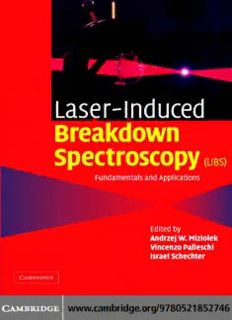
LASER-INDUCED BREAKDOWN SPECTROSCOPY (LIBS) PDF
Preview LASER-INDUCED BREAKDOWN SPECTROSCOPY (LIBS)
This page intentionally left blank LASER-INDUCED BREAKDOWN SPECTROSCOPY (LIBS) Laser-inducedbreakdownspectroscopy(LIBS)isanemergingtechniquefordetermining elementalcompositioninreal-time.Withtheabilitytoanalyzeandidentifychemicaland biologicalmaterialsinsolids,liquids,andgaseousformswithlittleornosamplepreparation, itismoreversatilethanconventionalmethodsandisidealforon-siteanalysis. ThisisthefirstcomprehensivereferencebookexplainingthefundamentalsoftheLIBS phenomenon, its history, and its fascinating applications across 18 chapters written by recognizedleadersinthefield.Over300illustrationsaidunderstanding. Thisbookwillbeofsignificantinteresttoresearchersinchemicalandmaterialsanalysis withinacademia,government,military,andindustry. Andrzej W. MiziolekisaSeniorResearchPhysicistattheUSArmyResearchLabo- ratory.Hisworkiscurrentlyconcentratedonnanomaterialsresearchandonthedevelopment oftheLIBSsensortechnology. Vincenzo Palleschi isaresearcherintheInstituteforChemical-PhysicalProcesses attheItalianNationalResearchCounciland,inparticular,theAppliedLaserSpectroscopy Laboratory. Israel Schechter is Professor of Chemistry in the Department of Chemistry at the Technion–IsraelInstituteofTechnology.Hismainscientificinterestisinnewmethodsfor fastanalysisofparticulatematerials. LASER-INDUCED BREAKDOWN SPECTROSCOPY (LIBS) Fundamentals and Applications Editedby ANDRZEJ W. MIZIOLEK USArmyResearchLaboratory VINCENZO PALLESCHI InstitutoperiProcessiChimico-Fisici,Italy ISRAEL SCHECHTER Technion–IsraelInstituteofTechnology,Haifa,Israel cambridge university press Cambridge, New York, Melbourne, Madrid, Cape Town, Singapore, São Paulo Cambridge University Press TheEdinburghBuilding,Cambridgecb22ru,UK Published in the United States of America by Cambridge University Press, New York www.cambridge.org Information on this title: www.cambridge.org/9780521852746 © A. Miziolek, V. Palleschi and I. Schechter 2006 This publication is in copyright. Subject to statutory exception and to the provision of relevant collective licensing agreements, no reproduction of any part may take place without the written permission of Cambridge University Press. First published in print format 2006 isbn-13 978-0-511-24529-9eBook (EBL) isbn-10 0-511-24529-7 eBook (EBL) isbn-13 978-0-521-85274-6hardback isbn-10 0-521-85274-9 hardback Cambridge University Press has no responsibility for the persistence or accuracy of urls for external or third-party internet websites referred to in this publication, and does not guaranteethatanycontentonsuchwebsitesis,orwillremain,accurateorappropriate. Contents List of contributors page x Preface xv 1 HistoryandfundamentalsofLIBS 1 DavidA.CremersandLeonJ.Radziemski 1.1 Introduction 1 1.2 Basicprinciples 1 1.3 CharacteristicsofLIBS 5 1.4 LIBSasananalyticaltechnique 17 1.5 EarlyLIBSinstruments 27 1.6 ComponentsforaLIBSapparatus 30 1.7 Conclusion 36 1.8 References 36 2 Plasmamorphology 40 IsraelSchechterandValeryBulatov 2.1 Introduction 40 2.2 Experimentalimagingtechniques 41 2.3 Time-integratedmorphology 59 2.4 Time-resolvedmorphology:excitationbymediumlaserpulses (1–100ns) 73 2.5 Time-resolvedmorphology:excitationbylonglaserpulses(>100ns) 110 2.6 Time-resolvedmorphology:excitationbyshortlaserpulses(fs–ps) 112 2.7 Time-resolvedmorphology:excitationbydoublelaserpulses 113 2.8 Conclusions 118 2.9 References 118 3 Fromsampletosignalinlaser-inducedbreakdownspectroscopy:acomplex routetoquantitativeanalysis 122 E.Tognoni,V.Palleschi,M.Corsi,G.Cristoforetti,N.Omenetto,I.Gornushkin, B.W.SmithandJ.D.Winefordner 3.1 Introduction 122 3.2 Thecharacteristicsoflaser-inducedplasmasandtheirinfluenceon quantitativeLIBSanalysis 123 v vi Contents 3.3 Quantitativeanalysis 148 3.4 Conclusions 164 3.5 Appendix.Tableofrepresentativelimitsofdetection 166 3.6 References 167 4 Laser-inducedbreakdowningases:experimentsandsimulation 171 ChristianG.Parigger 4.1 Introduction 171 4.2 Laser-inducedignitionapplication 172 4.3 Focalvolumeirradiancedistribution 173 4.4 HydrogenBalmerseriesatomicspectra 176 4.5 Diatomicmolecularemissionspectra 177 4.6 SimulationbyuseoftheprogramNEQAIR 179 4.7 Computationalfluiddynamicsimulations 186 4.8 Summary 189 4.9 References 191 5 AnalysisofaerosolsbyLIBS 194 UlrichPanneandDavidHahn 5.1 Introductiontoaerosolscience 194 5.2 Laser-inducedbreakdownofgases 209 5.3 AnalysisofaerosolsbyLIBS 217 5.4 ApplicationsofaerosolanalysisbyLIBS 242 5.5 Futuredirections 245 5.6 References 245 6 ChemicalimagingofsurfacesusingLIBS 254 J.M.VadilloandJ.J.Laserna 6.1 Introduction 254 6.2 LIBSchemicalimaging:operationalmodes 255 6.3 SpatialresolutioninLIBSimaging 258 6.4 ApplicationsofLIBSimaging 262 6.5 Concludingremarksandoutlook 277 6.6 References 279 7 BiomedicalapplicationsofLIBS 282 HelmutH.TelleandOtaSamek 7.1 Introduction 282 7.2 Investigationofcalcifiedtissuematerials 283 7.3 Investigationof“soft”tissuematerialswithcell structure 295 7.4 Investigationofbio-fluids 301 7.5 Investigationofmicroscopicbio-samples 304 7.6 Concludingremarks 309 7.7 References 309 Contents vii 8 LIBSfortheanalysisofpharmaceuticalmaterials 314 SimonBe´chardandYvesMouget 8.1 Introduction 314 8.2 Needsofthepharmaceuticalindustry 316 8.3 ComparisonofLIBSwiththecurrenttechnologies 317 8.4 ComponentsofaLIBSinstrumentforapplicationsinthe pharmaceuticalindustry 319 8.5 ApplicationsofLIBStotheanalysisofpharmaceutical materials 323 8.6 Conclusions 330 8.7 References 331 9 CulturalheritageapplicationsofLIBS 332 DemetriosAnglosandJohnC.Miller 9.1 Introduction 332 9.2 Artandanalyticalchemistry 333 9.3 WhyLIBSinculturalheritage? 333 9.4 Physicalprinciples 335 9.5 Instrumentation 336 9.6 Analyticalparametersandmethodology 338 9.7 ExamplesofLIBSanalysisinartandarchaeology 344 9.8 LIBSincombinationswithothertechniques 357 9.9 Concludingremarks 363 9.10 References 363 10 CivilianandmilitaryenvironmentalcontaminationstudiesusingLIBS 368 J.P.Singh,F.Y.Yueh,V.N.Rai,R.Harmon,S.Beaton, P.French,F.C.DeLucia,Jr.,B.Peterson,K.L.McNesbyand A.W.Miziolek 10.1 Introduction 368 10.2 ApplicationsoftheADAportableLIBSunit 370 10.3 ApplicationsofDIAL’sportableLIBSsystem 381 10.4 Conclusion 396 10.5 References 396 11 IndustrialapplicationsofLIBS 400 ReinhardNoll,VolkerSturm,MichaelStepputat,AndrewWhitehouse, JamesYoungandPhilipEvans 11.1 Introduction 400 11.2 Metalsandalloysprocessing 400 11.3 Scrapmaterialsortingandrecycling 409 11.4 Nuclearpowergenerationandspentfuelreprocessing 417 11.5 MiscellaneousindustrialapplicationsofLIBS 435 11.6 References 436 viii Contents 12 Resonance-enhancedLIBS 440 N.H.Cheung 12.1 Introductiontoresonance-enhancedLIBS 440 12.2 Basicprinciplesofspectrochemicalexcitationinlaser-induced plasmas 441 12.3 RELIPSanalysisofsolids 451 12.4 Liquidsamples 463 12.5 Gaseoussamples 473 12.6 Conclusion:resonance-enhancedLIBSasananalyticaltool 473 12.7 References 474 13 Short-pulseLIBS:fundamentalsandapplications 477 R.E.Russo 13.1 Introduction 477 13.2 Effectofpulsedurationonablation 478 13.3 Effectofpulsedurationonplasma 479 13.4 Picosecond-inducedelectronplasma 480 13.5 Femtosecondplasma 482 13.6 Short-pulseLIBS 483 13.7 Conclusion 487 13.8 References 488 14 High-speed,high-resolutionLIBSusingdiode-pumpedsolid-statelasers 490 HolgerBetteandReinhardNoll 14.1 Introduction 490 14.2 Diode-pumpedsolid-statelasers 491 14.3 Stateoftheart 494 14.4 ScanningLIBS 498 14.5 Laser-inducedcratergeometryandspatialresolutionofhigh-speed, high-resolutionscanningLIBSwithDPSSL 510 14.6 References 513 15 Laser-inducedbreakdownspectroscopyusingsequentiallaserpulses 516 JackPender,BillPearman,JonScaffidi,ScottR.Goodeand S.MichaelAngel 15.1 Introduction 516 15.2 Dual-pulseLIBS 517 15.3 Summary 532 15.4 References 534 16 MicroLIBStechnique 539 PascalFichet,Jean-LucLacour,DenisMenut,PatrickMauchien,Annie Rivoallan,Ce´cileFabre,JeanDubessyandMarie-ChristineBoiron 16.1 Introduction 539 16.2 Experimentalset-upforthemicroLIBSsystem 543 16.3 Resultsanddiscussion 547
Description: